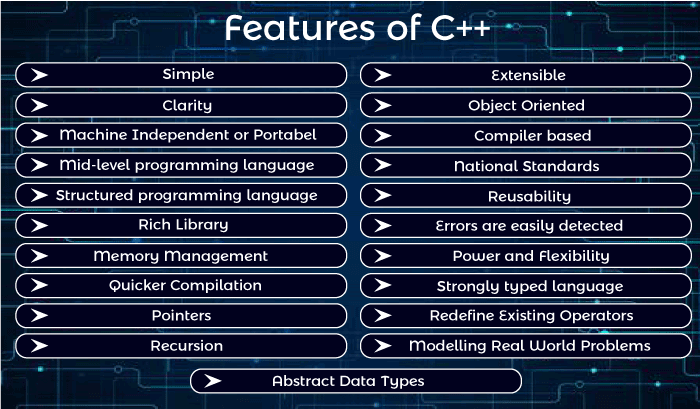C++ History(सी ++ का इतिहास )
C++ programming language was developed in 1980 by Bjarne Stroustrup at bell laboratories of AT&T (American Telephone & Telegraph), located in U.S.A.
Bjarne Stroustrup is known as the founder of C++ language.
It was develop for adding a feature of OOP (Object Oriented
Programming) in C without significantly changing the C component.
C++ programming is "relative" (called a superset) of C, it means any valid C program is also a valid C++ program.
(डिअर स्टूडेंट्स अगर आप सी ++ का इतिहास पड़ना चाहते है तो आप को कुछ स्टडी मैटेरियल्स पर ध्यान देना होगा जो मैंने आप के लिए कुछ टेबल्स में मेंशन कर रखे है |
तो आप इन पॉइंट्स को बहुत अच्छे से पढ़ लीजिए तो ही आपको कुछ पॉइंट्स समझ आ सकता है }
तो प्लीज जस्ट रीड आउट }....... )
Let's see the programming languages that were developed before C++ language.
| Language | Year | Developed By |
|---|---|---|
| Algol | 1960 | International Group |
| BCPL | 1967 | Martin Richard |
| B | 1970 | Ken Thompson |
| Traditional C | 1972 | Dennis Ritchie |
| K & R C | 1978 | Kernighan & Dennis Ritchie |
| C++ | 1980 | Bjarne Stroustrup |
C++ Features(फीचर्स )
C++ is object oriented programming language. It provides a lot of features that are given below.

- Simple(सिंपल)
- Machine Independent or Portable(मशीन इंडिपेंडेंट और पोर्टेबल )
- Mid-level programming language(मिड लेवल प्रोग्रामिंग लैंग्वेज )
- Structured programming language(स्ट्रक्चर्ड प्रोग्रामिंग लैंग्वेज )
- Rich Library(रिच लाइब्रेरी )
- Memory Management(मेमोरी मैनेजमेंट)
- Fast Speed(फ़ास्ट स्पीड )
- Pointers(पॉइंटर्स )
- Recursion(रिकर्शन )
- Extensible(एक्सटेंसिबल)
- Object Oriented
- Compiler based
तो स्टूडेंट्स अपने इनके फीचर्स तो पड़ ही लिए होंगे लेकिन मै इन फीचर्स को और एक्सप्लेन करना चाहता हु तो मैंने निचे हेडिंग वाइज कुछ डिस्क्रिप्शन लिख रखे है आप उनको पढ कर इनके फीचर्स के बारे में और अच्छे से जान पाएंगे( सो जस्ट सी बिलो। )
1) Simple( सिंपल)
C++ is a simple language in the sense that it provides structured approach (to break the problem into parts), rich set of library functions, data types etc.
2) Machine Independent or Portable(मशीन पर डिपेंड न होना )
Unlike assembly language, c programs can be executed in many machines with little bit or no change. But it is not platform-independent.
3) Mid-level programming language(मिडिल लेवल प्रोग्रामिंग )
C++ is also used to do low level programming. It is used to develop system applications such as kernel, driver etc.
It also supports the feature of high level language. That is why it is known as mid-level language.
4) Structured programming language(क्रमबृद्ध प्रोग्रामिंग करना )
C++ is a structured programming language in the sense that we can break the program into parts using functions. So, it is easy to understand and modify.
Rich Library(रिच लाइब्रेरी )
C++ provides a lot of inbuilt functions(पहले से बने हुए फंक्शन्स) that makes the development fast.
6) Memory Management(मेमोरी मैनेजमेंट )
It supports the feature of dynamic memory allocation. In C++ language, we can free the allocated memory at any time by calling the free() function.
7) Speed(स्पीड )
The compilation and execution time of C++ language is fast.
8) Pointer(पॉइंटर)
C++ provides the feature of pointers. We can directly interact with the memory by using the pointers.
We can use pointers for memory, structures, functions, array etc.
9) Recursion(रिकर्शन )
In C++, we can call the function within the function. It provides code reusability for every function.
10) Extensible(एक्सटेंसिबल )
C++ language is extensible because it can easily adopt new features.
11) Object Oriented(ऑब्जेक्ट ओरिएंटेड )
C++ is object oriented programming language. OOPs makes development and maintenance easier where as in Procedure-oriented programming language it is not easy to manage if code grows as project size grows.
12) Compiler based(कम्पाइलर बेस्ड )
C++ is a compiler based programming language, it means without compilation no C++ program can be executed. First we need to compile our program using compiler and then we can execute our program.
Comments
Post a Comment